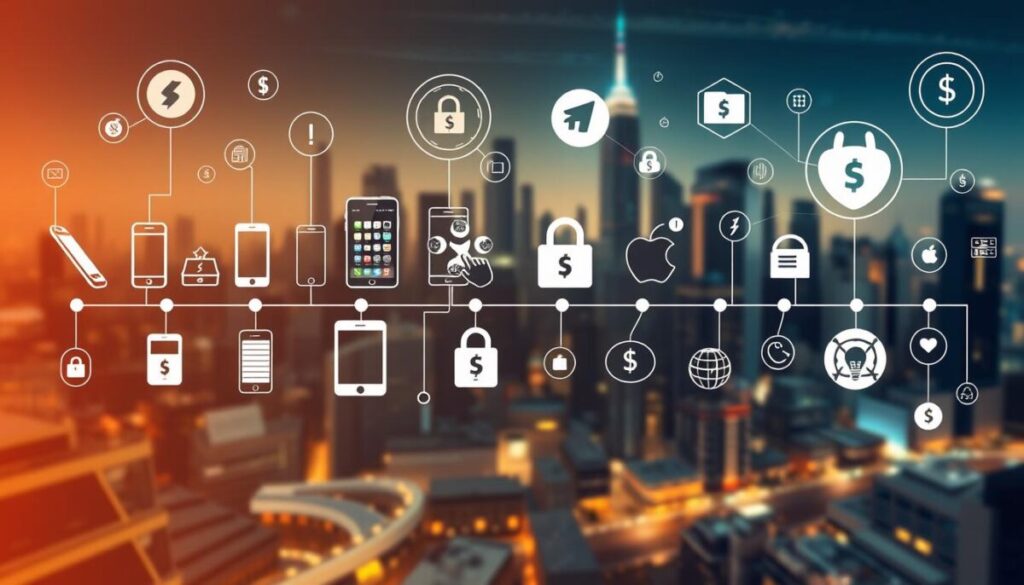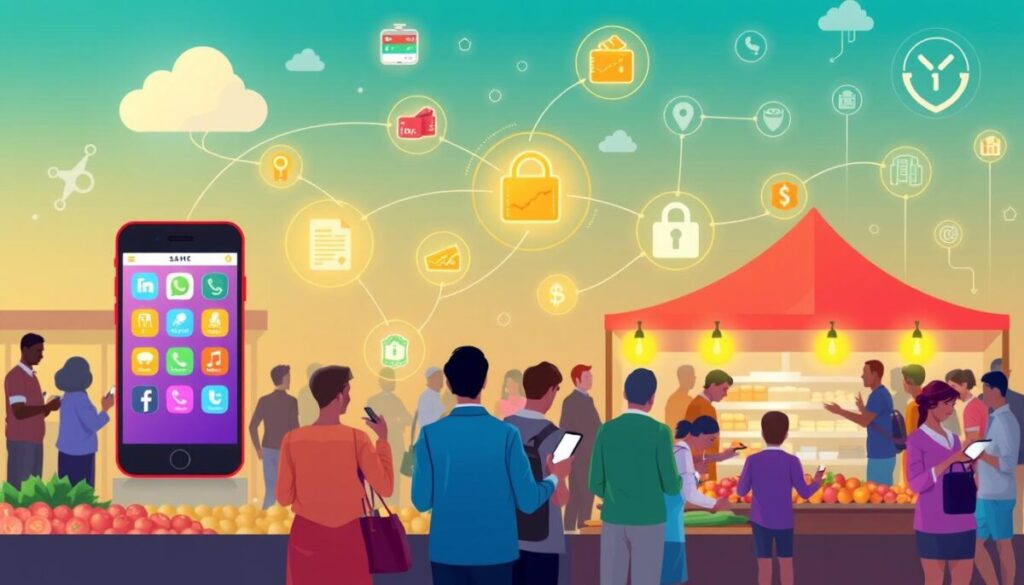The landscape of mobile payment technologies is rapidly evolving, with remarkable growth. The global mobile payment market, valued at $67.5 billion in 2023, is expected to reach $587.52 billion by 2030. This growth highlights the need for secure mobile payments. It shows how consumers and businesses are turning to innovative financial solutions.
Advancements in near-field communication (NFC) and two-factor authentication (2FA) enhance transaction efficiency and security. Yet, in a world filled with cybersecurity threats, understanding payment security is crucial. Users must protect their financial information from phishing and malware threats.
Smartphone users are projected to exceed 7.7 billion by 2028, driving mobile payment adoption. As I delve into this topic, I recognize the importance of balancing convenience with security in mobile payment technologies.
Introduction to Mobile Payment Technologies
Mobile payment technologies have transformed how we make transactions, allowing us to buy things digitally with our phones. With the advent of mobile wallets like Apple Pay and Google Pay, we can pay securely without cash or physical cards. The growing use of mobile payment platforms underscores the need for strong security to safeguard our financial data.
These systems enable users to handle various transactions, including direct billing, QR code scans, and NFC technology. NFC mobile wallet payments make transactions quick and easy, just by tapping our phones at checkout. Digital wallets securely store our payment info, authorizing transactions with encryption and tokenization, thus reducing fraud risks.
Mobile wallet services offer more than just in-store convenience; they also streamline online shopping. Mobile web payments allow us to shop online using our devices’ browsers or apps, charging purchases to our bank accounts or credit cards. QR code scanning, available in apps like Starbucks, speeds up payments when we shop in stores.
As we use these mobile payment platforms, we must stay vigilant about security risks. Researchers in the field of mobile payments are continually working to enhance transaction security. They integrate telecommunications, wireless networking, and security protocols to fight fraud and unauthorized access. This ongoing research ensures our financial data remains protected as we move forward in the digital commerce landscape.
The Evolution of Mobile Payment Technology
The history of mobile payment technology is a remarkable journey. It’s marked by significant technological advancements and changing consumer needs. In 2014, only 14 percent of mobile users in the U.S. made a mobile payment. By 2015, this figure jumped to 39 percent, as people started to embrace digital transactions. This shift laid the groundwork for the growing reliance on mobile payment solutions.
Key players like PayPal, launched in 1994, set the stage for a thriving ecosystem. Apple Pay’s introduction in 2014, followed by Android and Samsung Pay in 2015, further transformed mobile payments. These advancements allowed for quick and secure transactions, marking a significant shift in consumer finance engagement.
As mobile wallets became mainstream, projections indicated that by 2017, around 70 percent of mobile users in the U.S. would have used mobile payments. The appeal of these technological advancements became clear as services like Venmo processed over $1 billion in mobile peer-to-peer transfers in January 2016 alone. These milestones highlighted the rapid evolution and adaptation of the sector to consumer behaviors.

From 2015 to 2019, the total value of transactions from tapping mobile phones on in-store terminals skyrocketed. It reached projections of $210 billion, up from just $8.7 billion. This dramatic shift showed the growing trust in mobile payments and the demand for seamless shopping experiences. Looking ahead, the industry for digital payments is expected to hit US$9.46 trillion in transaction value by 2023. This underscores the expanding importance of mobile payment solutions within the financial ecosystem. The forecast for mobile wallets predicts a staggering growth to $16.2 trillion by 2031, highlighting the increasing adoption and user-friendly nature of these platforms.
Aside from traditional payments, the adoption of “Buy Now Pay Later” solutions reflects the evolving digital payments landscape. Young consumers, particularly Gen Z and Millennials, are driving this change. Mobile peer-to-peer payments are also projected to exceed $1 trillion in transaction volume by 2023. This shows the increasing relevance of this method in the mobile payment ecosystem. The evolution of mobile payments has indeed transformed the financial landscape, offering consumers greater flexibility and choice.
The Mobile Payment Ecosystem
The mobile payment ecosystem is a complex network of technologies and services that improve how we pay. At its core are digital wallets like PayPal, Apple Pay, and Alipay, which bring convenience and security to transactions. In the U.S., PayPal leads with 36% user preference, while Alipay and WeChat Pay dominate in China, showing different regional preferences.
Recent innovations, such as tap-to-pay, have gained immense popularity. This shift reflects the growing demand for easy transactions, prompting businesses to embrace mobile payment services. The U.S. now has five faster payment methods for various transactions, significantly improving payment processing.
SameDay ACH enables transactions under $1 million to be processed on the same day, speeding up digital transactions. The Real-Time Payments (RTP) system, introduced recently, is the first bank-to-bank payment system in over 57 years. FedNow allows instant payments 24/7, ensuring transactions are completed in under 20 seconds. These advancements are driving a shift towards instant payments.
Real-time payments also enhance security. They use biometric authentication and real-time fraud detection for added protection. Over 1,800 banks and credit unions partner with Zelle for secure, quick transfers, making the mobile payment ecosystem more reliable.
Mobile payment systems are crucial for financial inclusion, reaching those without bank accounts. Regulators are creating frameworks for mobile financial services, ensuring protection and data security. This evolution allows fintech startups to innovate with real-time payment APIs, creating new financial products and valuable transaction data.
As businesses adopt these systems, new models like subscription services and microtransactions are becoming more common. The global mobile payment market is expected to grow by nearly 24% annually until 2026. This growth highlights the need for businesses to integrate into this dynamic ecosystem.

Security Concerns with Mobile Payments
In today’s digital world, mobile payment security is crucial. As more people use mobile transactions, the risks grow. It’s vital to understand the vulnerabilities to protect our financial data. I will discuss common vulnerabilities that both users and merchants should know to keep their information safe.
Common Vulnerabilities in Mobile Payments
Mobile payments face threats like data breaches and unauthorized access, especially from lost or stolen devices. Cybercriminals use phishing attacks to get sensitive info from users. Unlike traditional credit cards, mobile payments lack physical security, making them more vulnerable to fraud. To stay safe, it’s essential to keep software updated and use strong security features like two-factor authentication and encryption.
Impact of Malware on Mobile Payment Security
Malware targeting mobile devices is a big problem for mobile payment security. Studies show about 50% of banking malware targets Android users, increasing the risks of mobile transactions. Malware can cause huge financial losses and identity theft. Using advanced technologies like RASP for real-time risk detection is key. Educating users and implementing effective fraud prevention strategies can boost mobile payment security. This will help build trust and encourage more people to use mobile payments.



